|
Sunday:
March 7, 2004 | |
0331 GMT |
 |
Tumbleweed rover goes on a roll at South Pole
A balloon-shaped robot explorer that one day could search for evidence that water existed on other planets has survived some of the most trying conditions on planet Earth during a 70-kilometer (40-mile), wind-driven trek across Antarctica.
 FULL STORY FULL STORY
 |  |

|
 |
Research shows heavy smoke 'chokes' clouds
Using data from NASA's Aqua satellite, agency scientists found heavy smoke from burning vegetation inhibits cloud formation. The research suggests the cooling of global climate by pollutant particles, called "aerosols," may be smaller than previously estimated.
 FULL STORY FULL STORY
 |  |
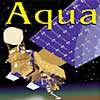
|
 |
|
Saturday:
March 6, 2004 | |
0420 GMT |
 |
Volcanic rock in Gusev Crater hints at past water
NASA's Spirit has found hints of a water history in a rock at Mars' Gusev Crater, but it is a very different type of rock than those in which NASA's Opportunity found clues to a wet past on the opposite side of the planet.
 FULL STORY FULL STORY
 |  |

|
 |

Video coverage for subscribers only:
 VIDEO: FRIDAY'S SCIENCE AND ROVER STATUS BRIEFING QT VIDEO: FRIDAY'S SCIENCE AND ROVER STATUS BRIEFING QT
 SUBSCRIBE NOW SUBSCRIBE NOW

|
|
Friday:
March 5, 2004 | |
0001 GMT |
 |
Hubble picture of space phenomenon imitates art
"Starry Night," Vincent van Gogh's famous painting, is renowned for its bold whorls of light sweeping across a raging night sky. Although this image of the heavens came only from the artist's restless imagination, a new picture from NASA's Hubble Space Telescope bears remarkable similarities to the van Gogh work, complete with never-before-seen spirals of dust swirling across trillions of miles of interstellar space.
 FULL STORY FULL STORY
 |  |

|
 |
Working to understand the very early Universe
Using a British radio telescope called the Very Small Array, astronomers have made measurements of the Cosmic Microwave Background -- radiation left over from the Big Bang -- which shed new light on events in the first minute fraction of the Universe's existence.
 FULL STORY FULL STORY
 |  |
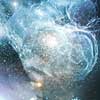
|
 |
IN OTHER NEWS Additional stories making news today
|
 |
Attendance at new museum passes half million mark -- The National Air and Space Museum's Steven F. Udvar-Hazy Center has welcomed more than a half million visitors since the Smithsonian facility in Chantilly, Va., opened to the public Dec. 15.
|
 |
|
Thursday:
March 4, 2004 | |
0001 GMT |
 |
Rosetta's comet target seen from Earth telescope
The European Space Agency's Rosetta spacecraft was launched this week to rendezvous with Comet 67P/Churyumov-Gerasimenko. Astronomers using the New Technology Telescope at the European Southern Observatory of La Silla in Chile have imaged the "dirty snowball" comet.
 FULL STORY FULL STORY
 |  |

|
 |
New IMAX 3-D film project goes lunar with Tom Hanks
The IMAX Corporation and Academy Award-winning actor Tom Hanks are making a new IMAX 3-D space film called "Magnificent Desolation." The film will take moviegoers to the moon and allow them to walk side-by-side with the brave astronauts of the Apollo program.
 FULL STORY FULL STORY
 |  |
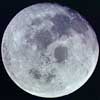
|
 |
IN OTHER NEWS Additional stories making news today
|
 |
Soyuz to launch Galileo -- Starsem and Arianespace announced Wednesday at Satellite 2004 the signing with the European Space Agency of the Galileo System Test Bed contract for the launches of two experimental Galileo satellites by two Soyuz launch vehicles.

NASA fills key positions -- Two veteran astronauts have been named to key space flight posts at NASA's Johnson Space Center in Houston. Robert Cabana, who has flown on four shuttle flights, has been named JSC Deputy Director. Kenneth Bowersox, who recently commanded the sixth expedition to the International Space Station, will replace Cabana as Director of Flight Crew Operations.

Astronaut Bloomfield named director of athletics -- Colonel Mike Bloomfield has been named the director of athletics at the Air Force Academy, according to an announcement by Superintendent Lt. Gen. John Rosa. Bloomfield is a 1981 graduate of the Academy and a former Falcon football player.
|
 |
|
Wednesday:
March 3, 2004 | |
0016 GMT |
 |
Rover confirms past liquid water on Mars
NASA's Opportunity rover, studying exposed bedrock in the crater where it landed by chance in January, has found clear evidence that Mars once supported a wet, habitable environment, one that would have been suitable for life, scientists announced Tuesday.
 FULL STORY FULL STORY
 MISSION STATUS CENTER - updates MISSION STATUS CENTER - updates
 EARLIER STORY EARLIER STORY
 ROVER NEWS ARCHIVE ROVER NEWS ARCHIVE
 |  |
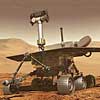
|
 |

Video coverage for subscribers only:
 VIDEO: WATCH TUESDAY'S ANNOUNCEMENT NEWS CONFERENCE QT VIDEO: WATCH TUESDAY'S ANNOUNCEMENT NEWS CONFERENCE QT
 VIDEO: 3-D TOPOGRAPHIC MODEL OF OPPORTUNITY CRATER QT VIDEO: 3-D TOPOGRAPHIC MODEL OF OPPORTUNITY CRATER QT
 VIDEO: PANORAMA OF ROCK OUTCROP WITH NARRATION QT VIDEO: PANORAMA OF ROCK OUTCROP WITH NARRATION QT
 SUBSCRIBE NOW SUBSCRIBE NOW

|
Are black holes fuzzballs?
In 1997, the three cosmologists made a famous bet as to whether information that enters a black hole ceases to exist -- that is, whether the interior of a black hole is changed at all by the characteristics of particles that enter it.
 FULL STORY FULL STORY
 |  |

|
 |
IN OTHER NEWS Additional stories making news today
|
 |
NRO mission to be first Atlas 5 flight from upgraded pad -- International Launch Services, a Lockheed Martin Corp. joint venture, has been given the green light for what will be the first Atlas 5 launch from Vandenberg Air Force Base, Calif. The launch will be from Space Launch Complex (SLC) 3-East, which is being refurbished to support a late 2005 launch for this national security mission.

Commercial Proton to launch WORLDSAT 3 satellite -- International Launch Services will provide a Russian Proton rocket to launch the WORLDSAT 3 communications satellite, under a contract with Alcatel Space of Paris announced today.
|
 |
|
Tuesday:
March 2, 2004 | |
1035 GMT |
 |
Rosetta soars on ambitious comet intercept mission
Embarking on its epic voyage to gain new insights into comets and the history of our solar system, the Rosetta spacecraft was successfully launched Tuesday to rendezvous with a cosmic snowball and deploy a tiny lander onto its icy heart.
 FULL STORY FULL STORY
 MISSION STATUS CENTER - updates MISSION STATUS CENTER - updates
 |  |
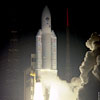
|
 |
Enigmatic X-rays may point to new class of black holes
Mysterious, powerful X-ray sources found in nearby galaxies may represent a new class of objects, according to data from NASA's Chandra X-ray Observatory. These sources, which are not as hot as typical neutron-star or black-hole X-ray sources, could be a large new population of black holes with masses several hundred times that of the sun.
 FULL STORY FULL STORY
 |  |

|
 |
|
Monday:
March 1, 2004 | |
1655 GMT |
 |
Mars atmosphere discovery
Astronomers have detected hydrogen peroxide in the atmosphere of Mars for the first time. This is the first time that a chemical catalyst of this sort has been found in a planetary atmosphere other than the Earth's. Catalysts control the reactions of the most important chemical cycles in the Earth's atmosphere.
 FULL STORY FULL STORY
 |  |
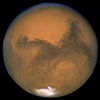
|
 |
Rosetta's voyage to comet poised to launch tonight
Delayed several days to replace a patch of foam insulation on the Ariane 5 rocket, launch of the Rosetta comet probe has been rescheduled for early Tuesday.
 FULL STORY FULL STORY
 MISSION STATUS CENTER - updates MISSION STATUS CENTER - updates
 ROSETTA FACT SHEET ROSETTA FACT SHEET
 LAUNCH EVENTS TIMELINE LAUNCH EVENTS TIMELINE
 |  |
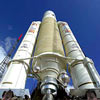
|
 |
Observatory's new optics show how stars form
Astronomers have taken advantage of a recently mounted laser guide star system at Lick Observatory to obtain sharp, twinkle-free images of the faint dusty disks of distant massive stars. The images clearly show that stars two to three times larger than the sun form in the same way as solar-type stars -- inside a swirling spherical cloud that collapses into a disk, like that from which the sun and its planets emerged.
 FULL STORY FULL STORY
 |  |

|
 |
IN OTHER NEWS Additional stories making news today
|
 |
JPL announces new exploration office, management changes -- In a move designed to align the lab with NASA's new exploration agenda outlined by President George W. Bush, Dr. Charles Elachi, director of NASA's Jet Propulsion Laboratory, Pasadena, Calif., has announced personnel changes and the formation of a new office at JPL.

NASA creates management office -- NASA's Deputy Administrator, Fred Gregory, named Jeffrey E. Sutton as the agency's Assistant Administrator, Office of Institutional and Corporate Management. The new office (Code O) will provide technical expertise, policy oversight and overall leadership for NASA's institutional, corporate, infrastructure and management systems activities.
|
 |

